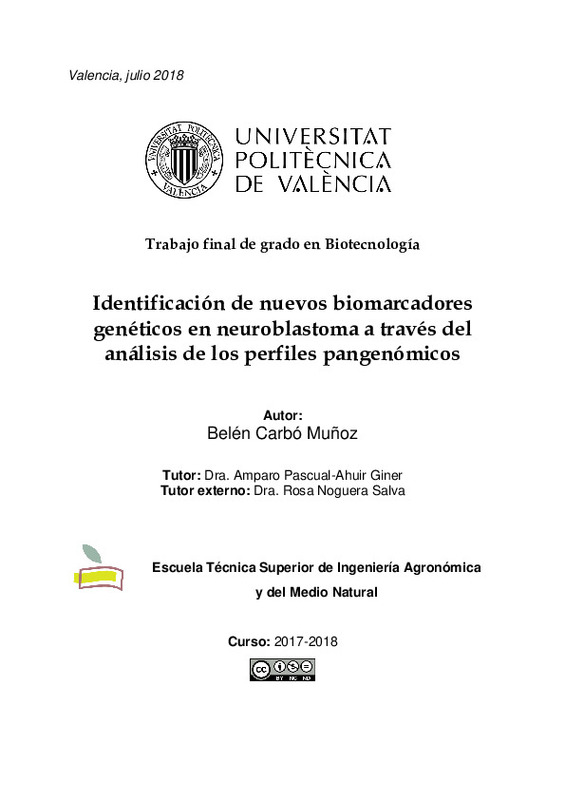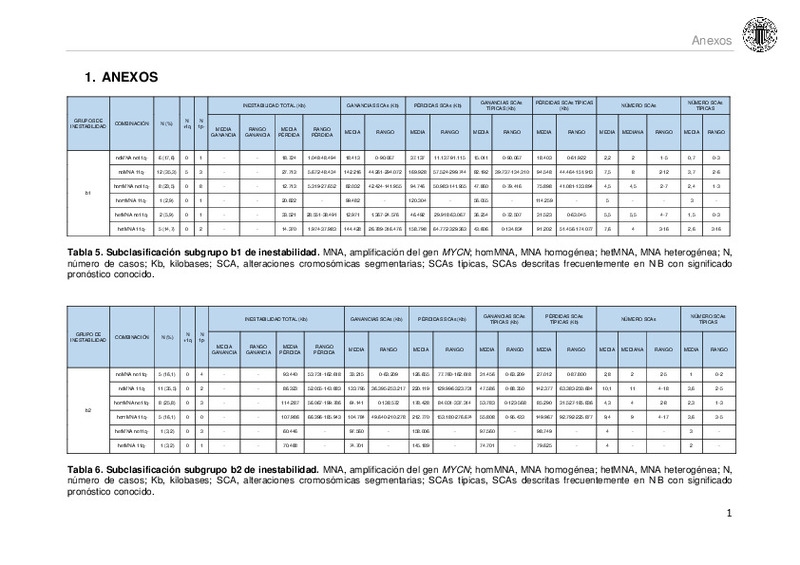|
Resumen:
|
[ES] El neuroblastoma es el tumor sólido extracraneal más común durante la infancia y
deriva de las células precursoras del sistema nervioso simpático. Es el responsable
del 15% de muertes en niños con cáncer y se ...[+]
[ES] El neuroblastoma es el tumor sólido extracraneal más común durante la infancia y
deriva de las células precursoras del sistema nervioso simpático. Es el responsable
del 15% de muertes en niños con cáncer y se caracteriza por ser una enfermedad
con una gran heterogeneidad clínica, genética, histológica y biológica. Los factores
pronósticos considerados en la estratificación de riesgo pretratamiento de los
pacientes son: el estadio, la edad, la histopatología (categoría y grado de
diferenciación), la ploidía y alteraciones cromosómicas específicas como la
amplificación del gen MYCN y la deleción del brazo cromosómico 11q; de esta
forma, se clasifica a los pacientes según su riesgo de muerte en los grupos: Muy
Bajo, Bajo, Intermedio y Alto (Very Low, Low, Intermediate y High Risk).
El laboratorio de la Dra. Rosa Noguera está llevando a cabo un proyecto en el que
se analizan los perfiles pangenómicos obtenidos mediante arrays de SNPs (Single
Nucleotide Polimorfisms). En este trabajo, colaboré en el estudio de 195 tumores
neuroblásticos, para evaluar el número total de alteraciones cromosómicas
segmentarias, la localización cromosómica de estas alteraciones, y el tamaño total
de material genético ganado y perdido, así como la presencia de alteraciones
focales (bien en amplificaciones o bien en ganancias o pérdidas) y alteraciones
cromosómicas numéricas. El objetivo fue determinar si existía una asociación entre
la cantidad de material genético ganado y/o perdido (en kilobases) y el número de
alteraciones segmentarias o numéricas cromosómicas. Consideramos que
relacionando estos resultados con la clínica de los pacientes y el riesgo de recaída
o muerte podemos contribuir en el desarrollo de nuevas estrategias terapéuticas en
neuroblastoma.
[-]
[EN] Neuroblastoma is the most common extracranial solid tumor during childhood
and is derived from the precursor cells of the sympathetic nervous system. It is
responsible for 15% of deaths in children with cancer and ...[+]
[EN] Neuroblastoma is the most common extracranial solid tumor during childhood
and is derived from the precursor cells of the sympathetic nervous system. It is
responsible for 15% of deaths in children with cancer and is characterized as a
disease with great clinical, genetic, histological and biological heterogeneity. The
prognostic factors considered in the pretreatment risk stratification of patients are:
stage, age, histopathology (category and degree of differentiation), ploidy and
specific chromosomal alterations such as the amplification of the MYCN gene
and the deletion of the 11q chromosome arm; in this way, patients are classified
according to their risk of death in the Very Low, Low, Intermediate and High Risk.
The laboratory of Dr. Rosa Noguera carries out a project in which the
pangenomic profiles obtained by arrays of SNPs (Single Nucleotide
Polimorfisms) are analyzed. In this work, I will collaborate in the study of 195
neuroblastic tumors, to evaluate the total number of segmental chromosomal
alterations, the chromosomal location of these alterations, and the total size of
genetic material gained and lost, as well as the presence of focal alterations (well
in amplifications or gains or losses) and numerical chromosomal alterations. The
objective is to determine if there is an association between the amount of genetic
material gained and/or lost (in kilobases) and the number of chromosomal
segmental or numerical alterations. We believe that by relating these results to
the patients' clinic and the risk of relapse or death we can contribute to the
development of new therapeutic strategies in neuroblastoma.
[-]
|








